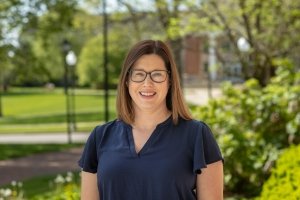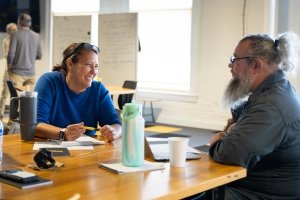
Centre students play key role in “We Were Here” exhibition
Anthropology and sociology students learned just how comprehensive collecting data can be when they helped acquire and edit oral histories for the Danville Boyle County African American Historical Society.
Now, those oral histories play a key role in listening stations that help the “We Were Here” exhibition come to life in the Norton Center for the Arts’ foyer.
“’We Were Here’: The African American Experience in Boyle County” began as a community-based learning partnership and grew into a large multimedia installation at the Norton Center, which will tell its story for the entirety of the 2022-23 school year. The oral histories narrate the experience of African Americans living in Danville and Boyle County in the middle part of the 20th Century in their own words, when multiple urban renewal projects and school desegregation were changing the community forever.
Danville native Ethan Scott ’25 said that his family’s history in the community gave him a unique look at the project.
“My grandparents have lived in Danville since the 60s or 70s. That was prime time for these urban renewal efforts,” Scott said. “I’ve asked my parents who grew up here, they thought of it as a project or improvement in the city’s infrastructure. To them, it wasn’t something that was the complete removal and fragmentation of a community. For me, that was powerful. That right there tells a story in itself, how people choose to remember the history of Danville.”
Three years ago, at the Soul of Second Street Festival, Centre Visiting Assistant Professor of Anthropology Jeffrey Shenton met Michael Hughes, president of the Danville-Boyle County African American Historical Society. The Society puts on the festival each year to celebrate Danville’s Black history. Shenton and Hughes then partnered to expose more Centre students to this history. One of the first fruits of this partnership was the idea to train students to collect oral histories, which the Historical Society had wanted for some years to do at a larger scale.
“In ANT 110, we talk about ‘transcripts of history,’ or how is it that different groups of people create their own narratives about places meaningful to them. The narrative in ‘We Were Here’ had to be pieced together from boxes in attics, people’s half-memories,” Shenton said. “It’s a reflection of something that was untold for so long. We have the public record from the Danville Advocate-Messenger, which is one version of what happened during this time. But the version that you see from attics and memory is totally different version of what that place looked like.”
Students like Claire Edelen ’24 participated in gathering the oral histories that help tell the stories of those who lived during the urban renewal projects that tore down some of Danville’s Black communities. Edelen said it was an emotional moment for her when she realized just how urban renewal impacted the individuals she was speaking with.
“It sunk in that the splintering and destroying of a place doesn’t just destroy that physical space, it destroys the community that is there, the connections, the families that had been built there before,” Edelen said. “I started to see it in the subtleties of the way the people we interviewed talked about community. Before the process of urban renewal began, they talked about children and families: children could be admonished by their neighbor, or just go and hop over to someone else’s house for dinner, that sort of thing. [After urban renewal] there was a shift to more singular experiences of family rather than a community experience.”
Hughes meets with students regularly at the historical society: Shenton’s classes are frequent visitors, and Hughes has hosted Governor’s Scholar Program students at the History Center on North Second St. in Danville.
Hughes takes students through photographs of what Second Street was – black owned business and community – to what it is today, Constitution Square. He said that students are “blown away” by what they see.
“I want people to see what it used to be, see how people loved it,” Hughes said. “I think if people see the photos, they can see what Danville was. People are proud of that. Now, people don’t know how the system worked to change Second Street. The system wasn’t considering peoples’ lives and businesses. Through this project, people can see what Danville used to be.”
While Centre College played a role in parts of Danville’s urban renewal projects in the middle of the 20th century, it has eagerly supported the “We Were Here” Project, both Shenton and Hughes said. From Norton Center Executive Director Steve Hoffman giving the green light and securing funding for the exhibit, to the college working with him and the Historical Society, the support has been “tremendous.”
“For me a big component of people coming to Centre’s campus is to see and experience this story,” Edelen said. “It’s a powerful experience to see that and confront that on Centre’s campus. I visited the exhibit with a different class, and the reactions of students who had no idea that the Northside dorm was built on a street and land that used to be a black neighborhood. That first visceral reaction, ‘oh I live there.’
“I was first introduced to the oral history project through ANT 110,” Edelen continued. “I thought it was an amazing piece of history, but I didn’t think I could contribute in any way. Entering Dr. Shenton’s Linguistic Anthropology class, being able to be a part of it and talk with those people, that was uniquely amazing.”
The Exhibition is a partnership between the Norton Center, the Danville-Boyle County African American Historical Society, and Centre College’s Program in Anthropology and Sociology. The exhibit is open to the public Monday through Friday, 9 a.m. to 4 p.m.



